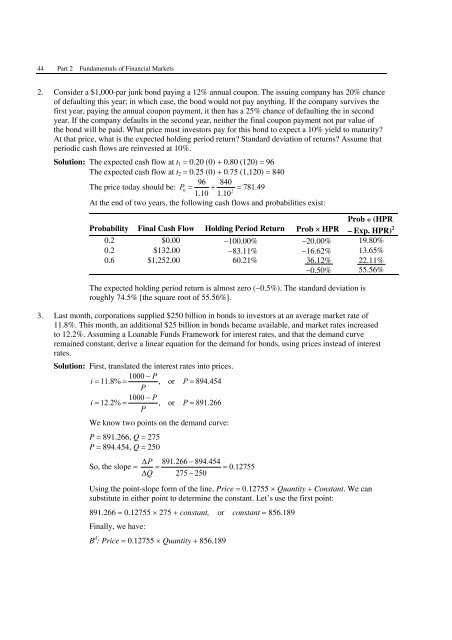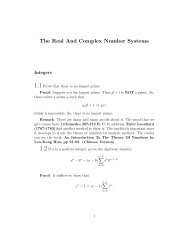Answers to End-of-Chapter Questions
Answers to End-of-Chapter Questions
Answers to End-of-Chapter Questions
Create successful ePaper yourself
Turn your PDF publications into a flip-book with our unique Google optimized e-Paper software.
44 Part 2 Fundamentals <strong>of</strong> Financial Markets<br />
2. Consider a $1,000-par junk bond paying a 12% annual coupon. The issuing company has 20% chance<br />
<strong>of</strong> defaulting this year; in which case, the bond would not pay anything. If the company survives the<br />
first year, paying the annual coupon payment, it then has a 25% chance <strong>of</strong> defaulting the in second<br />
year. If the company defaults in the second year, neither the final coupon payment not par value <strong>of</strong><br />
the bond will be paid. What price must inves<strong>to</strong>rs pay for this bond <strong>to</strong> expect a 10% yield <strong>to</strong> maturity<br />
At that price, what is the expected holding period return Standard deviation <strong>of</strong> returns Assume that<br />
periodic cash flows are reinvested at 10%.<br />
Solution: The expected cash flow at t 1 = 0.20 (0) + 0.80 (120) = 96<br />
The expected cash flow at t 2 = 0.25 (0) + 0.75 (1,120) = 840<br />
96 840<br />
The price <strong>to</strong>day should be: P<br />
0<br />
= + = 781.49<br />
2<br />
1.10 1.10<br />
At the end <strong>of</strong> two years, the following cash flows and probabilities exist:<br />
Probability Final Cash Flow Holding Period Return Prob × HPR<br />
Prob * (HPR<br />
– Exp. HPR) 2<br />
0.2 $0.00 −100.00% −20.00% 19.80%<br />
0.2 $132.00 −83.11% −16.62% 13.65%<br />
0.6 $1,252.00 60.21% 36.12% 22.11%<br />
−0.50% 55.56%<br />
The expected holding period return is almost zero (−0.5%). The standard deviation is<br />
roughly 74.5% [the square root <strong>of</strong> 55.56%].<br />
3. Last month, corporations supplied $250 billion in bonds <strong>to</strong> inves<strong>to</strong>rs at an average market rate <strong>of</strong><br />
11.8%. This month, an additional $25 billion in bonds became available, and market rates increased<br />
<strong>to</strong> 12.2%. Assuming a Loanable Funds Framework for interest rates, and that the demand curve<br />
remained constant, derive a linear equation for the demand for bonds, using prices instead <strong>of</strong> interest<br />
rates.<br />
Solution: First, translated the interest rates in<strong>to</strong> prices.<br />
1000 − P<br />
i= 11.8% = , or P=<br />
894.454<br />
P<br />
1000 − P<br />
i= 12.2% = , or P=<br />
891.266<br />
P<br />
We know two points on the demand curve:<br />
P = 891.266, Q = 275<br />
P = 894.454, Q = 250<br />
ΔP<br />
891.266 −894.454<br />
So, the slope = = = 0.12755<br />
ΔQ<br />
275 −250<br />
Using the point-slope form <strong>of</strong> the line, Price = 0.12755 × Quantity + Constant. We can<br />
substitute in either point <strong>to</strong> determine the constant. Let’s use the first point:<br />
891.266 = 0.12755 × 275 + constant, or constant = 856.189<br />
Finally, we have:<br />
B d : Price = 0.12755 × Quantity + 856.189
















